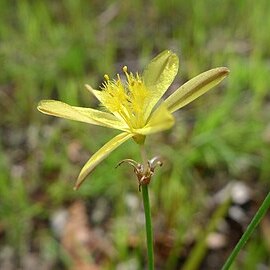Perennial herbs with short rhizomes. Roots fibrous. Leaves basal, lanceolate or linear, or reduced to scales along branches. Flowering axis branched, bracteate, each branch with a terminal umbel. Flowers bisexual, actinomorphic; pedicels articulate above middle. Perianth yellow; segments free, spirally twisted after anthesis, later deciduous. Sepals 3, 3-or rarely 5-7-nerved. Petals 3. Stamens 6, attached to base of perianth; filaments filiform, with a tuft of narrow clavate hairs below anther; anthers dorsifixed, introrse, dehiscing by slits. Ovary superior, subglobose, deeply 3-lobed, 3-locular; ovules few per locule; placentation basal; style filiform; stigma simple, papillate. Fruit a schizocarp; mericarps 1-3, sometimes umbonate. Seed 1 per mericarp, black; endosperm fleshy.

